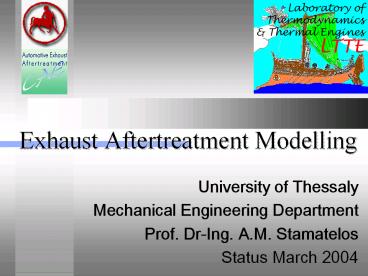Exhaust Aftertreatment Modelling - PowerPoint PPT Presentation
Title:
Exhaust Aftertreatment Modelling
Description:
Automotive Exhaust Aftertreatment CAE: Current state of the art ... Computer-Aided Engineering Methodologies are introduced to reduce development and testing time. ... – PowerPoint PPT presentation
Number of Views:475
Avg rating:3.0/5.0
Title: Exhaust Aftertreatment Modelling
1
Exhaust Aftertreatment Modelling
- University of Thessaly
- Mechanical Engineering Department
- Prof. Dr-Ing. A.M. Stamatelos
- Status March 2004
2
Otto Diesel Exhaust Aftertreatment Modelling
- The Laboratory of Thermodynamics Thermal
Engines of the University of Thessaly, Mechanical
Industrial Engineering Department, possesses
and further develops CAE methodologies and tools
regarding the modelling of Automotive Exhaust
Aftertreatment Systems comprising Catalytic
Converters Diesel Filters. - Our computational tools are characterized by an
engineering approach in the chemical reaction
modelling, relying on apparent kinetics, partly
tunable to the results of routine full scale
tests (engine bench or chassis dyno tests).
3
Automotive Exhaust Aftertreatment In-house CAE
Software Tools
University of Thessaly Mechanical Industrial
Engineering Department Laboratory of
Thermodynamics Thermal Engines (LTTE)
- HEATRAN Exhaust Systems Heat Transfer Modeling
Software - CATRAN 3-Way Catalytic Converter Modeling
Software - CATRAN NOx Adsorber Catalytic Converter Modeling
Software - CATWALL Diesel Particulate Filter Regeneration
Modeling Software 1D or 3D with ANSYS-CATWALL
interfacing - KONSTAN Exhaust emissions test data quality
assurance software - DARWIN Kinetic Parameter Estimation Software
(based on GAs)
4
RD Activities /funding in Automotive Exhaust
After-Treatment CAE
- University of Thessaly
- Mechanical Industrial Engineering Department
- Laboratory of Thermodynamics Thermal Engines
- (LTTE)
- Fundamental Research (Long Term)
- Funding provided by EC and interested
Industrial Partners - Development of Computer-Aided Engineering
Methodologies - (Medium Term)Funding provided by EC and
Industrial Partners - Transfer of CAE Software and Knowhow (Short
Term) Against - payment of license fees and charging of
man-hours allocated to project - Consulting Services and Design Optimization Case
Studies (Short - Term) Charging fees based on man-hours
allocated to project
5
Transfer of knowhow
- Transfer of software and knowhow to certain
automotive, exhaust systems and catalytic
converters manufacturers is in progress - This transfer includes understanding from our
industrial partners, of the algorithm and the
input and output data structures of our catalytic
converter, filter heat transfer modelling
software - Cooperation with industrial partners also covers
the definition and customization of experiments
and tests that support the modelling of different
types of catalytic converter, filter exhaust
piping
6
Automotive Exhaust Aftertreatment CAE Current
state of the art
- Requirements of exhaust aftertreatment systems
performance are continuously increasing, with
increasingly stringent legislation - Computer-Aided Engineering Methodologies are
introduced to reduce development and testing
time. They are based on in-house software - Keeping an acceptable accuracy in the prediction
of emissions over the NEDC and FTP-75 cycles,
becomes increasingly difficult - Commercial software (CFD) cannot be conveniently
extended to cover prediction of transient exhaust
emissions at converter exit
7
LTTE in-house CAE methodologies
- The LTTE in-house software is tailored to the
needs of the automotive and exhaust systems
designer - The basic points of its underlying philosophy
are - recognition of the minimum required degrees of
freedom - ability to fastly and efficiently perform
transient simulations - employment of routine test results in model
tuning. Quality assurance of test data. - integrated system optimization based on a modular
software structure that covers a wide range of
aftertreatment devices
8
Basic Features of LTTE Catalytic Converter
Diesel Filter Models
- Kinetics reduced pragmatic net reaction rates
- Diffusion Thiele modulus approach
- Activity profiles lumped into net reaction rates
- Washcoat layers lumped into net reaction rates
- Heat mass transfer 1-D, Nu /Sh approach
- Cell shape lumped into effectiveness
- Washcoat shape lumped into effectiveness
- Canningincluded (2-D for converters, 3-D for
filters) - Exhaust piping included (1-D)
- Monolith shape and cpsi included
- Effect of Precious metal loading empirical
approach - Exhaust gas maldistribution included (2-D, 3-D)
- Typical input data 1-10 Hz test cycle modal data
- Front-end MS EXCEL macros or MATLAB/SIMULINK
9
Experimental input to CAE Tools
- LTTE in-house CAE methodologies use apparent
kinetics and rely on full scale tests for model
tuning (engine bench or chassis dyno tests,
legislated cycles or parts thereof) - The results of laboratory experiments and tests
that provide fundamental data (i.e. light-off,
lambda sweep, oxygen storage assessment tests
etc) may also be processed and taken into account
in model tuning.
10
Further development of LTTE in-house CAE
Methodologies
- Our CAE methodologies are already being employed
in automotive exhaust after-treatment design, and
transferred to industrial partners - They are complete methodologies in the sense that
they support the design optimization of exhaust
after-treatment systems starting from routine
engine bench/chassis dyno tests results - Based on this experience, our kinetics tuning,
pre- and post-processing tools and methodolo-gies
are further developed and customized

